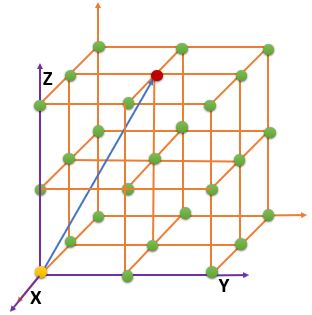Miller Indices (hkl), is the set of number which indicates the orientation of plane or set of parallel planes of atoms in a crystal. It is calculated by taking reciprocals of fractional intercepts taken along the three crystallographic direction and it is written inside parenthesis withous comma.
Miller indices notations :
(hkl) => Plane
{hkl} => Family of Planes
[hkl] => Direction
<hkl> => Family of direction
Steps to calculate miller indices :
Example 1:
| Steps |
X |
Y |
Z |
| Intercept |
\[ 1 \] |
\[ 1 \] |
\[ \infty \] |
| Reciprocal |
\[ 1 \] |
\[ 1 \] |
\[ 0 \] |
| Rationalise |
\[ 1 \] |
\[ 1 \] |
\[ 0 \] |
| Miler Indices |
\[ (1 1 0) \] |
Example 2:
| Steps |
X |
Y |
Z |
| Intercept |
\[ 1 \] |
\[ 1 \] |
\[ \frac{1}{2} \] |
| Reciprocal |
\[ 1 \] |
\[ 1 \] |
\[ 2 \] |
| Rationalise |
\[ 1 \] |
\[ 1 \] |
\[ 2 \] |
| Miler Indices |
\[ (1 1 2) \] |
Example 3:
Here the axis is not passing through the intercept. In such cases we have to shift the origin.

| Steps |
X |
Y |
Z |
| Intercept |
\[ \frac{1}{2} \] |
\[ 1 \] |
\[ \infty \] |
| Reciprocal |
\[ 2 \] |
\[ 1 \] |
\[ 0 \] |
| Rationalise |
\[ 2 \] |
\[ 1 \] |
\[ 0 \] |
| Miler Indices |
\[ (2 1 0) \] |
Question :Find the miller indices of given vector in below figure
 Show Answer
Show Answer
Answer : [-2 2 1]
Here all the axis is not passing through the intercept. In such cases we have to shift the origin.

| Steps |
X |
Y |
Z |
| Intercept |
\[ -1 \] |
\[ 1 \] |
\[ 2 \] |
| Reciprocal |
\[ -1 \] |
\[ 1 \] |
\[ \frac{1}{2} \] |
| Rationalise |
\[ -2 \] |
\[ 2 \] |
\[ 1 \] |
| Miler Indices |
\[ [-2 2 1] \] |
- Plane which are close to origin have higher miller indices than plane which are far away from origin
- If a plane is parallel to any axis then its corresponding miller index on that axis wll be zero
- Two parallel planes will have same Miller Indices . Note :- Sign may change depending on there position.
- Angle between two planes having miller indices \( ( h_{1} k_{1} l_{1}) \) and \( ( h_{2} k_{2} l_{2}) \) will be -
\[ cos (\theta) = \frac{ h_{1}h_{2} + k_{1}k_{2} + l_{1}l_{2}}{ \sqrt{h_{1}^2 + k_{1}^2 + l_{1}^2} \times \sqrt{h_{2}^2 + k_{2}^2 + l_{2}^2} } \]
- Two planes having miller indices \( ( h_{1} k_{1} l_{1}) \) and \( ( h_{2} k_{2} l_{2}) \) will be perpendicular to each other when -
\[ h_{1}h_{2} + k_{1}k_{2} + l_{1}l_{2} = 0 \]
Interplanar spacing is the separation between sets of parallel planes formed by the individual atoms in the lattice structure considering one plane passing through origin.
\[ d = \frac{a}{\sqrt{h^2 + k^2 + l^2}} \]
Where a = Lattice parameter
Question :The inter-planar spacing between the (2 2 1) planes of a cubic lattice of edge length 900 nm is: __________ nm
Show Answer
Answer : d = 300nm
As given a = 900nm
And Miller indices of plane is (2 2 1)
=> \( d = \frac{900}{\sqrt{2^2 + 2^2 + 1^2}} nm \)
=> \( d = \frac{900}{ 3 } \)
=> \( d = 300nm \)
For HCP, the miller indices are denoted as (uvtw) for planes and [uvtw] for direction.
Note: Here t = - (u + v)
 Basal Plane & direction:
Basal Plane & direction: \( (0 0 0 1)[1 1 \bar{2} 0] \)
Prismatic Plane & direction: \( (1 0 \bar{1} 0)[1 1 \bar{2} 0] \)
Basal Plane & direction: \( (\bar{1} 0 1 1)[1 1 \bar{2} 0] \)
 Learn Metallurgy
Learn Metallurgy


 Show Answer
Show Answer

 Basal Plane & direction: \( (0 0 0 1)[1 1 \bar{2} 0] \)
Basal Plane & direction: \( (0 0 0 1)[1 1 \bar{2} 0] \)